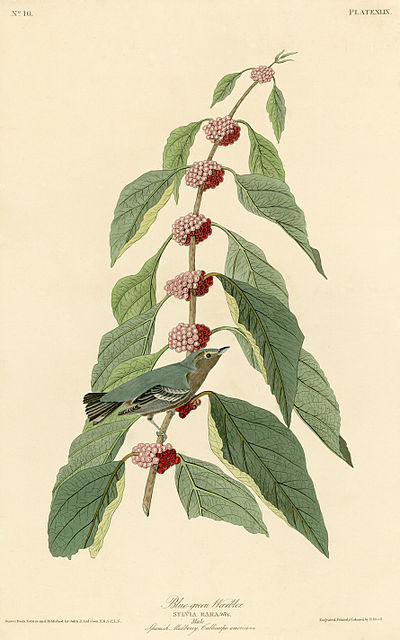Ornithological Biography/Volume 1/Blue-green Warbler

THE BLUE-GREEN WARBLER.
Sylvia rara, Wils.
PLATE XLIX. Male.
The Blue-green Warbler so resembles the young of the Azure Warbler, that were not the form of its bill, and some of its habits, considerably different, I should be tempted to consider it a mere variety of that bird. It is equally rare in the Middle Districts, where I have shot only a few, and these in the dark recesses of the Great Pine Swamp.
On its passage through the States, it is found in Louisiana, where it appears in the beginning of April. This lateness of its arrival indicates its coming from a great distance, most of the other species appearing several weeks earlier. They seem to disperse soon after, as on their first appearance several may be procured in one day, as well as during their equally short stay in autumn, when, again, I have shot six or seven from a single tree, on which they appeared as busily engaged as if so many Tit-mice. I have met with them singly and far apart in Kentucky, in Ohio, upon the Missouri, and along Lake Erie, but I have never found their nest.
In spring it has a soft and mellow song, which is not heard beyond the distance of a few paces. It is performed at intervals between the times at which the bird secures an insect, which it does with great expertness, either on wing, or amongst the leaves of the trees and bushes. The tops of trees, however, appear to please them best, the reverse being the case with the Azure Warbler.
The Blue-green Warbler has a peculiar cunning manner of leaning downwards to view a person, or while searching for an insect, and which is very different from that of any other bird, although I am unable to describe it. While thus leaning, it moves its head sidewise so very slowly that the motion is hardly perceptible, unless much attention is paid to it. After this, it either starts off and flies to some distance from the observer, or darts towards the prey that had attracted its notice. While catching an insect on the wing, it produces a slight clicking sound with its bill, and in this respect approaches the Vireos. Like some of them also, it descends from the highest tops of the trees to low bushes, and eats small berries, particularly towards autumn, when insects begin to fail.
Its flight is performed in zigzag lines of a few yards, as if it were undetermined where to alight. I have found no difference between the sexes as to external appearance.
The plant on which I have figured a male is found in Louisiana, growing along the skirts of woods and by fences. It is called the Spanish Mulberry. It is a herbaceous perennial plant, attaining a height of from four to eight feet. The fruits are eaten by children, but are insipid.
Sylvia rara, Blue-green Warbler, Wils. Amer. Ornith. vol. iii. p. 119. PI. 27. fig. 2.—Ch. Bonaparte, Synops. of Birds of the United States, p. 82.
Adult Male. Plate XLIX.
Bill longish, nearly straight, depressed at the base, tapering to a point. Nostrils basal, oval, half concealed by the feathers. Head and neck of ordinary size. Body ovate. Feet of ordinary length, rather slender; tarsus compressed, covered anteriorly with a few long scutella, acute behind, rather longer than the middle toe; toes scutellate above, free; claws arched, slender, much compressed, acute.
Plumage blended, soft and tufty. Wings longish, little curved, the first and second quills longest. Tail shortish, rounded, of twelve rather acute feathers.
Bill dark brown above, light blue beneath. Iris dark brown. Feet light blue. General colour of the upper parts light greenish-blue, of the under parts white. A white streak over the eyes. Tips of the two first rows of wing-coverts white, forming two bands across the wing. Quills blackish-brown, their outer margins blue. Tail blackish-brown, the outer feathers having a white patch on the inner web near the end.
Length 4¾ inches, extent of wings 8; bill along the ridge ⅓, along the gap ½; tarsus ⅔.
The Spanish Mulberry.
Callicarpa americana, Willd. Sp. PI. vol. i. p. 619. Pursh, Fl. Amer. vol. i. p. 97.—Tetrandria Monogynia, Linn. Vitices, Juss.
A perennial herbaceous plant, with oval, serrate leaves, which are downy beneath; sessile cymes of red flowers, and globular red berries, arranged apparently in dense whorls. It grows in dry gravelly or sandy soil, in Virginia, Carolina, and Louisiana.
